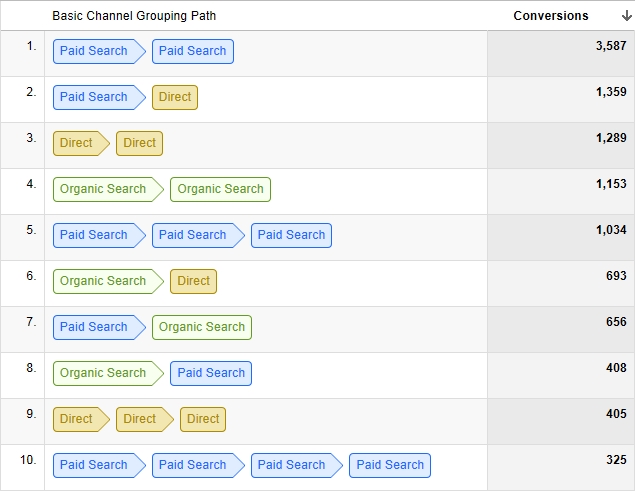What To Do When Traffic Doesn’t Equal Sales
So you're getting decent traffic, but sales aren't up. What's the problem? Columnist Casie Gillette offers suggestions on where to look for answers.
Attend any SEO conference and the conversation around metrics and KPIs inevitably comes up. What should I measure? How do I calculate ROI? How do I prove my value?
These are obviously good questions, and my response is always the same: money.
As digital marketers, we have the ability to track our efforts through tools like analytics, and while perhaps we can’t track every single thing, technology has certainly enabled us to track the majority of what we do online.
The challenge with this is that sometimes we find we don’t like what the data have to say. Sometimes, all of the work we’ve put in doesn’t translate into what matters. Traffic doesn’t translate into money. And that’s a problem.
To be honest, there can be any number of reasons why people are coming to your site but not converting. For example, the site may be slow, the landing page may not be relevant, or perhaps the landing page isn’t optimized for the right part of the buying cycle. But often there’s more to it.
So what do you do when your SEO program is driving traffic but isn’t driving leads? Let’s take a look.
Reevaluate Attribution
During a sales call, a potential client told us they had never acquired a single customer from their PPC program, despite the fact it had sent thousands of visits and hundreds of leads.
Either they had the worst PPC team on the face of the planet or something wasn’t adding up.
It turns out, despite having an eight- to 12-month sales cycle, if a prospect didn’t respond to a call within 30 days, the company removed them from the opportunities list. Meaning even if the prospect did end up becoming a customer eight months down the road, paid search received no credit.
When thinking about your online marketing efforts and attribution in general, it’s imperative to look at the whole picture. On top of that, we must consider the buying cycle itself and understand how the various channels are playing a role in each phase.
Enter multi-channel attribution.
Attribution modeling is tough (Go read this post from Avinash Kaushik), and most companies are still trying to figure this out. But before you completely discount a channel, dig deeper into your analytics.
Look at both first-click conversions and last-click conversions, look at assisted conversions, and most importantly, evaluate conversion paths.
If your search program is geared toward reaching those at the top of the funnel, and you know the average customer visits five to six times before taking an action, by the time they actually decide to convert, they are probably coming back directly versus through organic or paid search. That doesn’t mean those channels don’t have value.
As we continue moving into this multi-channel and multi-device world, we will need to evolve how we report and how we attribute sales to truly understand ROI and measure our marketing efforts.
Analyze Landing Page Data
A couple of months ago, we were talking with a client who asked a question I thought was so simple, yet so on point:
“What do our most successful pages have in common?”
As we dug in, we took a hard look at the keyword targets, the actual keywords sending traffic, the intent around those keywords and the page content itself. We found that the pages performing the best and driving the greatest number of leads didn’t necessarily have the most content or the same calls to action, but the content that was on each page was most closely aligned with the queries driving traffic.
To analyze landing page performance and better understand your search traffic, I recommend starting with the following:
- Identify top organic landing pages (by conversions and conversion rate).
- Use WMT to find search queries driving traffic to each page.
- Evaluate on-page content and calls to action.
- Look at visitor paths from the landing page.
- Evaluate bounce rate and exit rate per page.
Once you have this information, you can begin answering the questions that really matter:
- Does the landing page content accurately reflect the keywords driving traffic?
- Does the content match the intent of the queries?
- If I were looking for this product or service, would the page have the information I need?
- Is there an easy way for me to find more information or take an action?
If you are driving users to pages that don’t match their search intent, they obviously aren’t going to convert. And if you are driving them to the right page, but you don’t have the information they need, that’s another problem.
In the age where customers want answers to their questions (and want them fast), you have to ensure you are giving them what they want.
Talk To Your Users
One thing we don’t do enough of in this industry is actually talk to the people visiting our (or our clients’) websites. Why? Because it’s time-consuming. And when you already have limited time and resources, prioritizing things like user studies can be a tough sell.
That doesn’t mean we shouldn’t try — or at least find tools to help us.
At my old job, we briefly implemented an exit pop-up on one of our sites. When a certain percentage of people went to exit the page they were on, a small survey would pop up, asking them why they were leaving.
The test only ran for a short time, but the information was invaluable, as it helped us uncover why users were leaving an important page on the site. In many cases, the person wasn’t finding the information they were looking for, and that meant we had to revise what was there. In other cases, people were simply doing research, and that reiterated the value of retargeting.
By asking the users directly, we received real-time feedback and were able to adjust our content and improve the user experience quickly.
For websites with hundreds of thousands of pages or hundreds of thousands of visitors, implementing a site-wide exit pop-up for each page might be reasonable; however, consider gathering data on your top pages to start, and go from there.
As search marketers, we must always remember that people are searching, people are visiting our sites, and people are buying our products. We have to make it about them.
Note: If you are interested in exit pop-ups, check out this post from Gleam.
Final Thoughts
The more we understand why people aren’t converting, the better chance we have of improving conversions and, in turn, the business.
More importantly, the more conversions we can attribute to search, the more we can show our value. Make sure you are looking at your data on an ongoing basis and continuously figuring out how to improve your site, not just for search, but for your buyers.
Opinions expressed in this article are those of the guest author and not necessarily Search Engine Land. Staff authors are listed here.
Related stories


